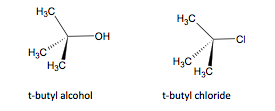Can an Sn1 Reaction be used to Convert an Alcohol to an Alkyl Halide?
Written by Brandon
Purpose: The purpose of this experiment was to use an SN1 reaction mechanism to synthesize t-butyl chloride (Alkyl Halide) from t-butyl alcohol.
Structures:
Reaction Equation:
Reaction Mechanism:
Calculations:
- Mass of Main fraction = mass of Jar & sample – mass of jar; ex: 57.741-49.737=8.004
- Percent Yield: (Actual/Theoretical)*100 ex: (8.004/14.72)*100 = 54.38%
Results:
- Mass of 1oz. Jar: 49.737g
- Forerun Temperature: 40-44
- Main Fraction Temperature: 44
- Mass of jar and main fraction: 57.741g
- Mass of Main fraction: 8.004g
- Percent Yield: 54.38%
- IR Peaks 2992, 2981= Cl-C stretch
Discussion:
- Our percent yield could be classified as on the high side because we got a percent yield of over 50%, meaning we were able to recover over half of the starting material as product. What could’ve caused this high percent yield was just an accurate experimental procedure with few errors that caused loss of product.
- Our boiling point range is slightly below the actual and this tells us that our experimentally gathered t-butyl chloride has some small impurities.
- The IR for the starting material has a very well defined OH bond peak and the IR of the product does not, so this tells us that we did in fact recover the product we intended to and that product has a relatively good purity.
- Our boiling point for t-butyl chloride was slightly below the known for the compound, this difference tells us that our recovered product has some slight impurities.
Conclusion: Based on our experimental results we can come to the conclusion that using an SN1 mechanism is a good way to synthesize t-butyl chloride from t-butyl alcohol and hydrochloric acid. We obtained 8.004g of recovered t-butyl chloride, givng us a percent yield of 54.38%. The solution we recovered was decently pure because its boiling point and IR peaks were both close to those for pure t-butyl chloride.

